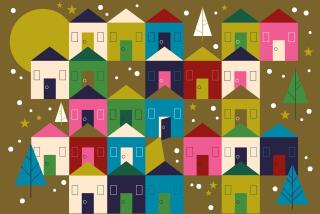Christmas Encompasses a Lot More Than Jesus’ Birth
- Share via
Advent is a season of joyful anticipation. It is a time of watching and waiting for the birth of the Christ child. I can remember one particular Christmas day when I was doubly joyful: I was nine months pregnant with my second child. Ryan was born the day after Christmas--a symbol to my husband and myself of the innocence, life and love that Jesus brought into the world.
In the church calendar, however, Christmas is not just a day but a season that lasts 12 days. It ends on Epiphany (the Twelfth Night, to some), with a celebration of the baptism of Jesus. Epiphany means recognition or insight, and it symbolizes our quest to constantly perceive the signs of Christ’s presence in our everyday lives. My husband and I had no idea that we were about to have an epiphany experience like no other.
Dusk was settling over our quiet bungalow one wintry evening a few weeks after Christmas when I, in my fluffy pink housecoat and slippers, went to check on baby Ryan. As I peeked into his baby-blue ruffled bassinet, I discovered the unthinkable. I had just finished infant CPR training the week before, learning the first rule is not to panic. I panicked. Nothing had prepared me for this moment.
In a few minutes we were in an ambulance en route to the nearest emergency room with sirens wailing. Inside I was wailing too, but I didn’t let out a sound. I rocked back and forth, praying that prayer common to all desperate mothers: “Oh, God, not my baby. Not my baby.”
I remember the interminable waiting, and then the young, scruffy doctor in the white coat and stethoscope drawing alongside me in the emergency room. He bent over and in a soft voice said he had some bad news. Ryan had apparently succumbed to Sudden Infant Death Syndrome.
Like most mothers, I was in full denial. This couldn’t be happening! Babies aren’t ever supposed to die, and especially not so soon after Christmas. “Just give him back to me and I’ll take him home and our family will be fine,” I remember thinking.
My faith foundations had received some tidal waves. They were shaken, but did not stir from their place, like the wise man who built his house on the rock. My faith traditions helped me through the funeral preparation, acute grieving process and subsequent time of mourning.
Because our pastor was out of town at the time, loving lay people came over to offer consolation and spontaneous prayers. There are parallels to this in other faith traditions: In the Greek Orthodox church, a priest is called to perform the “first prayers after death,” representing an affirmation of faith.
For Hispanic Catholics, a priest leads in the rosario de los muertos. Jews are comforted by reciting the “kaddish,” an ancient declaration of faith praising God.
I found that participating in the rituals of the funeral and graveside service helped facilitate the grieving process and brought a measure of closure. Ritual brings order, aesthetic beauty and comfort to displace the chaos, ugliness and devastation that I felt. Ritual links us to the past and says: “Others have made this journey, and you can too.” It was helpful to know that God knew what I was feeling. After all, he lost his son too.
This holiday season, as in that one, the act of lighting a candle helps me drive away the darkness and heaviness, and reminds me to let in the light of God’s love. As you light a candle, let its glow fill you with faith, hope and love--faith for today, hope for tomorrow, and love for your journey.
Attending a worship service can carry you from your own concerns into the loving presence of God. Be sure to thank God for your having been loved, and for the joy of sharing your love with others. Let your cherished memories of loved ones inspire you to the new opportunities for love that today brings.
Let religious symbols reinforce your faith beliefs. The menorah reminds us of God’s miraculous provision, the crucifix speaks of God’s unconditional love through Christ’s sacrifice, and the dove declares that we are not left alone but are empowered by the Holy Spirit.
In retrospect, I now recognize that for Christians the holiday season really encompasses Christ’s passion, death, resurrection, ascension and the sending of the Spirit (Advent-Christmas-Epiphany). This closely connects the crib, the cross and the crown (life, death and everlasting life). Ryan experienced the crib, the cross and the crown in a very short time. He has gone ahead of me in an untimely death, but I will surely follow.
During World War II it was found that orphans rested better through the night if they were given a piece of bread to cradle in their hands before going to sleep. This piece of bread assured them that they had eaten today and they would eat again tomorrow. Jesus stated that He is the bread of life. Because He lives, I ate today, and I will eat again tomorrow. And I will eat again and again, until I celebrate with Him for all eternity at the great banquet table of the Lamb. To God be the glory! Gloria in excelsis Deo!
Connie Regener, an Irvine resident and American Baptist minister, is a doctoral student at Fuller Theological Seminary. She also serves as a certified bereavement facilitator and California state peer contact for Sudden Infant Death Syndrome.
On Faith is a forum for Orange County clergy and others to offer their views on religious topics of general interest. Submissions, which will be published at the discretion of The Times and are subject to editing, should be delivered to Orange County religion page editor Jack Robinson at 1375 Sunflower Ave., Costa Mesa, CA 92626. Submissions also may be faxed to (714) 966-7711 or e-mailed to jack.robinson@latimes.com.


